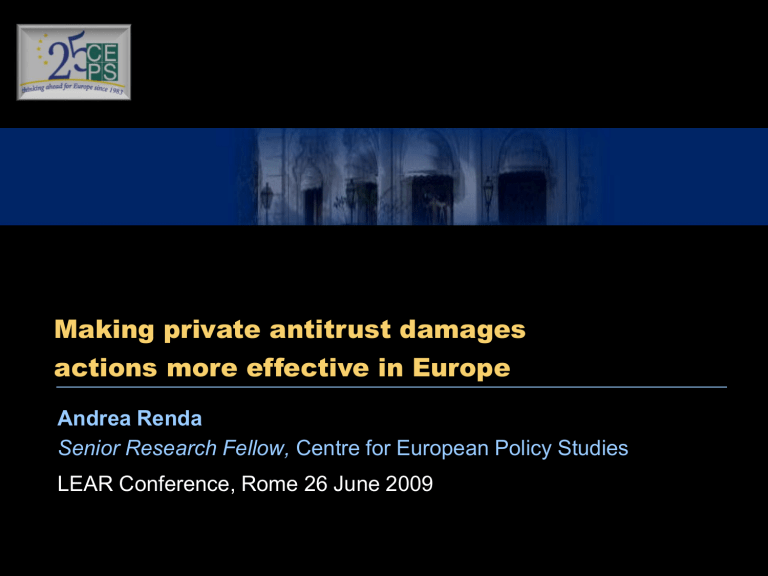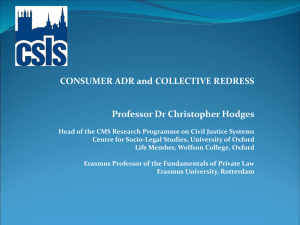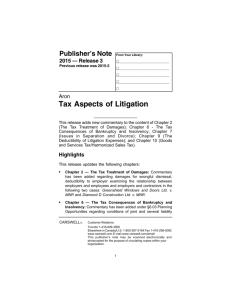Harm to Innovation as an Antitrust Claim

Making private antitrust damages actions more effective in Europe
Andrea Renda
Senior Research Fellow, Centre for European Policy Studies
LEAR Conference, Rome 26 June 2009
Introduction
Private antitrust litigation already exists in most of the EU27. But damages actions are very uncommon
Private enforcement is already possible since the Rome Treaty, as Articles 81 and 82 of the
Treaty are directly applicable in member states
Since 1973, the Commission has repeatedly expressed the view that private actions can provide a useful complement to its role as public enforcer
Modernization strenghtened this view, by decentralising the application of antitrust law
The ECJ decisions in Courage v. Crehan and
Manfredi highlighted the possibility for victims to claim damages before national courts
2
Existing obstacles in the EU
As reported by the
Ashurst Study in
2004, the major obstacles are access to evidence rules and legal uncertainty
EU antitrust was born as public enforcement
Victims often have limited knowledge of harm
Some violations are difficult to detect
Some conducts create scattered damages
Burden of proof (threshold), access to evidence
Absence of conditional/contingency fees
Quasi-absence of group litigation
“English rule”
Legal uncertainty
Lack of skills in courts
3
Persisting underdevelopment
A slight development of damages actions was observed in
2004-2007. But it is mostly confined to isolated streams of cases, and seldom successful
Ashurst study found “total underdevelopment”
60 actions and 23 damage awards in over 50 years
(plus settlements and arbitral awards)
From underdevelopment to fragmentation?
Between 1 st of May 2004 - 3Q2007, 96 antitrust damages actions for the EU27
Private antitrust damages actions were observed only in 10 of the EU27
Vertical restraints cases are the most common (61), but damages have never been awarded
Limited number of “clusters” of claims
4
2004-2007 developments
25
20
15
35
30
10
5
0
20
17
3
0
2004
33
21
9
3
2005
27
18
6
3
2006
16
7
4
5
3Q2007
Art. 81 (cartel)
Art. 81 (vertical)
Art. 82
Total
5
2004-2007 developments
15
10
5
0
30
25
20
AT BE DK ES
Art. 81 (cartel)
FR DE
Art. 81 (vertical)
IT NL SW UK
Art. 82
6
2004-2007 developments
100%
90%
80%
70%
60%
50%
40%
30%
20%
10%
0%
6
7
49
8
cartel
dismissed
9
vertical
successful
14
abuse
7
Awards by type of claim, 2004-07
Year
2004
2005
2006
2007 (I sem.)
Total
Vertical
(damages awarded)
22 (1)
30 (0)
13 (0)
3 (0)
68 (1) *
Abuse
(damages awarded )
11 (2)
12 (6)
5 (2)
1 (0)
29 (10) **
Cartel
(damages awarded)
3 (1)
6 (5)
-
2 (1)
11 (7)
Total
(damages awarded)
36 (4)
48 (11)
18 (2)
6 (1)
108 (18)
*The damage award in 2004 in the Crehan judgment was overturned by the House of Lords in 2006.
**The damages awarded in Attheraces Limited and another / British Horseracing Board have been repealed by the High Court, even if the parties had already settled the case for £1 million.
Why private damages actions?
9
Private antitrust damages actions can realise the
“invisible hand”: the self-interest of victims can favour the public interest
Corrective justice
Right to damages is rooted in Community law
ECJ in Courage (2001) and Manfredi (2006)
Additional deterrence
Public enforcers have limited resources
Damage awards add to public fines
“Private Attorneys Generals” can be more informed
Internal market effects
Exercise of the right to damage in the EU27
Level-playing field for firm engaging in crossborder trade
Macroeconomic effects
The “second pillar”
Private antitrust enforcement can effectively create a second pillar, but also more opportunities for strategic lawsuits and court error
Nature
Action
Firm 1
No action
Legal
Signal
Illegal
NCA (public enforcement)
Firm 1
No action Action
Signal
Illegal Legal
Nature Nature
Not guilty
(correct)
Guilty
(Type I)
Guilty
(correct)
Not guilty
(Type II)
Player 2
No action Action
Not guilty
(correct)
Guilty
(Type I)
Follow-on suits
Player 2
Action No action
Guilty
(correct)
Not guilty
(Type II)
10
Deterrence: “Magic formula”
When will a firm infringe?
Public enforcement Private damages actions
Expected liability
Probability of detection
Expected fine
Probability of detection
Expected award or settlement
Reputational effects
E(C) = p g c g
E(F) + p p c p
E(S) + E(R)
11
Probability of conviction
Probability of conviction
Deterrence: cartels (I)
According to some authors, the
“optimal fine” would reach several times the overcharge, or even more..
.. But there is a limit
(the firm’s ability to pay)
Source
Landes (1983)
USSD (1986:15)
Cohen and Scheffman (1989)
Beckstein and Gabel (1982)
Feinberg (1985:379)
Werden-Simon (1987)
Bryant-Eckard (1991)
OECD (2002: 19)
Golub et al. (2005)
Wils (2005:30)
Wils (2006: 24)
Schinkel (2006:25)
Bush et al. (2004)
Stucke (2006:47)
Combe-Monnier (2007)
Probability
0.33
0.10
0.33
Less than 0.50
Less than 0.50
Less than 0.10
0.13-0.17
0.13-0.17
0.13-0.17
Less than 0.33
0.16
0.15
0.10-0.33
unknown
0.129-0.132
12
Deterrence: cartels (II)
13
Source: Lande and Davis (2006)
Impact on the detection rate
Lande and Davis
(2008) analyse forty of the largest recent antitrust cases or group of cases in the US, and find a significant number of privately initiated cases
“…we were somewhat surprised at the high representation of private actions that were filed in the absence of government cases or that significantly expanded the relief obtained through government enforcement alone…
…of the total amount recovered almost half—at least forty-three to forty-seven percent; $7.631 to $8.981 billion
—came from the fifteen cases that did not follow federal, State, or EU government enforcement .
For each of the cases … the private plaintiffs completely uncovered the violations, and initiated and pursued the litigation, with the government following the private plaintiffs’ lead or playing no role at all.
Another $4.212 billion came from cases with a mixed private/public origin".
Lande and Davis (2008)
Deterrence: cartels (III)
15
Deterrence: cartels (IV)
16
17
Standing to sue
Anticompetitive conduct may damage different categories of players
The infringer should internalise all negative externalities it imposes
Several categories of cartel victims:
direct purchasers, downstream firms or final customers
indirect purchasers (if the overcharge was passed-on)
customers who purchased from fringe firms outside the cartel that charged a higher price as a non-cooperative response to the cartel price
those who would have purchased the cartel product, but who either did not purchase at all, or purchased a lesspreferred alternative outside the cartel
suppliers to the cartel or to other firms who sell products that contain the cartelised input, who both sell less because of the output restriction at the cartel price. This is the socalled “umbrella effect” of a cartel.
All of them have standing in the EU (but need to prove causation) – See ECJ in Manfredi (2006)
Another “Magic formula”
When will a victim sue?
Litigation part Settlement part
Expected damage award
Expected settlement
Litigation costs
Settlement costs p[wD – (OC t
+ LC t
+ AC)] + (1 – p)[S – (OC s
+ LC s
)] > 0
18
Probability of winning at trial
Winning and settling
Georgetown study data (1973-1983)
19
The costs of private enforcement
20
Litigation costs
Average lawyers’ fees reach 10%-20% of final awards in the US
Costs associated with enhanced private enforcement never outweigh the potential benefits, but can be significant
Court fees average 2%-6% of final award in the EU
Opportunity cost of litigation: 53%-79% of attorneys’ fees (Lande, 1993)
In Europe, would not be necessarily lower than in the US, despite the absence of contingency fees
Cost of the judicial system
Up to 16.5% of the nominal income transfer
(untrebled damage award)
Frivolous suits?
Private parties may have an incentive to strategically use the legal system to:
Many authors have reported cases of nuisance suits in the
US; lately, the
Supreme Court strengthened pleading requirements in
Twombly
Impose costs on rivals
Sue and settle
Gain access to confidential information
Incentives increase with:
Damage multiples
Low pleading thresholds
Asymmetric fee-shifting rules
21
Overshooting?
Over-deterrence
Measures that encourage too much litigation may even result in
“equilibrating tendencies”, such as in the US
Firms may refrain from adopting efficient behaviour because expected liability is too high
This is especially likely in vertical restraints and abuses (more generally, in rule of reason cases)
Over-compensation
Whenever a claimant is awarded more than the loss sustained
(Calkins, 1986
Kovacic, 2007)
May occur in case of duplicative liability (e.g. when passing-on defence is not allowed)
Necessary for access to justice?
Necessary for sufficient deterrence?
22
Harmonisation costs
Private antitrust enforcement can represent a new paradigm for Europe and access to justice.
Whatever measure is adopted to encourage private antitrust damages actions, harmonisation costs will be high
Damage multiples against ordre public in many countries
Also in the UK (See Devenish, 2007)
Limitation periods vary widely
Opt-out group litigation against constitutional principles in many Member States
But the way forward is still uncertain
Very difficult to change access to evidence rules
Harmonisation costs are one-off, benefits are
“from now on”
23
The “Impact Study”
The Commission made extensive use of the findings of the
Impact Study, although some of the final proposals diverge
Potential impact
The estimated yearly impact of EU-wide and domestic cartels falls between €25 and €69 billion
Cost of no action: foregone benefits for victims of antitrust infringement would range between €5.7 billion and €23.3 billion yearly
Upper bound scenario: recovery up to €35 billion yearly, net of legal expenses
Combined public and private enforcement can contribute up to 1% of GDP, or €117 billion (in 2006)
Costs never outweigh benefits
Lawyers‘ fees and court fees, which represent by far the largest portion of costs, would amount to approximately 15%-20% of damage recovery
24
Issues at stake
Multiple damages
Through the Impact
Study, the
Commission has explored more carefully these issues, and the combination of options that results therefrom
One-way fee-shifting (mandatory or discretional)
Group litigation
Access to evidence
Damage calculation
Passing-on (defense and offense)
Coordination with leniency programmes
Limitation periods
25
The “Impact Study”
Double damages for cartel cases
Based on a costbenefit analysis, the
Impact Study indicated a scenario in which a clear set of rules would be introduced for each of the measures at stake
Discretionary one-way fee-shifting
Opt-in collective + representative actions
Low pleading threshold based on fact-pleading
Passing-on (defense and offense)
Favour for a rebate on liability exposure of the leniency applicant
5 year (minimum) limitation period + 2 years for follow-on actions
26
27
The White Paper
Single damages plus interest (but punitive damages not excluded)
The White Paper leaves it to Member
States to decide on fee-shifting and court fees, and refrains from indicating a rule on leniency applicants
Discretionary cost protection orders
Opt-in collective + representative actions
Disclosure of precise categories of documents
Passing-on (defense and offense)
Further reflection on liability of leniency applicants
2 year limitation for follow-on actions
“Final” public decisions are binding on courts
info: andrea.renda@ceps.eu
Multiple damages
Damage multiples have an obvious problem: they are against the public order in the majority of member states
Multiple damages can increase deterrence, and to some extent also corrective justice
What damage multiple?
In Europe prejudgment interest is normally computed, so treble damages may prove excessive
In the US, due to absence of prejudgment Interest, the true multiplier is between 1.25 and 1.66 (See
Lande, 1993)
Also in the UK they were recently rejected in competition cases
Doubling of damages is more justified for cartels
This is due to the per se nature of the abuse, and the covert nature of the practice
In other types of cases, may lead to overdeterrence
Need to consider the likelihood of settlement
29
Fee-shifting: which rule?
In Europe, the loser-pays rule is dominant
Many different variants
The loser-pays rule may create obstacles for victims wishing to file a lawsuit, especially if the probability of winning is low
In the US, the rule is “each party bears own costs”
But in antitrust cases, the Clayton Act introduced
“mandatory one-way fee-shifting”
Loser-pays has important features
Encourages spending in litigation, especially in small stakes, high-probability cases
“Selection of cases” effect
May discourage actions in cases with low probability of victory (also due to strategic behaviour of the defendant)
30
One-way fee-shifting
Mandatory one-way fee-shifting
The White Paper leaves it to member states to adopt ex ante court-ordered cost protection for the claimant
Greatly encourages litigation
No “selection of cases”
Can also encourage frivolous lawsuits
Must be coupled with safeguards (e.g. offer-ofjudgment rules)
Discretionary one-way fee-shifting
Many countries have adopted some form of ex post, court-ordered fee-shifting
Should be done ex ante to encourage victims to file suit
31
Group litigation (I)
Group litigation is essential for the effectiveness of private antitrust enforcement
In Lande and Davis
(2008), all but six cases are class actions
Several options on the table
Opt-out class actions
Opt-in collective actions
Opt-out representative actions
Opt-in representative actions
Mandatory representative actions
Joinder of claims
Opt-out schemes inconstitutional in many MS
Different schemes for different allegations?
Different schemes for different plaintiffs?
32
Group litigation (II)
Type of litigation
Joinder of claims
Joinder of parties
Test cases
Representative opt-in
Representative opt-out
Representative mandatory
Collective opt-in
Collective opt-out
Collective mandatory
Germany, Austria
Country
Hungary, Romania, Spain, Bulgaria, France,
Sweden, UK, Greece, Baltic states, Sweden
Austria, Germany, UK, Sweden, Greece
Sweden, Finland, UK, Denmark, Italy
The Netherlands (settlement), Portugal,
Denmark
Germany, Bulgaria, Spain
Sweden, Denmark
Portugal
Spain
33
Group litigation (III)
Group litigation is essential for the effectiveness of private antitrust enforcement
In Lande and Davis
(2006), all but six cases are class actions
Representative actions: qualified entities
entities designated in advance by the Member States according to national procedures, representing legitimate and defined interests; and
other existing entities whose primary task would be to protect the defined interests of their members, certified on an ad hoc basis
Opt-in collective actions
The claimants themselves have suffered harm, and join their cases by sharing costs of producing evidence and litigating against the opponent
Compared to an opt-out system, such actions may lead to a lower number of represented victims, but also limit the risk of excesses and a “litigation boom”, and have lower harmonisation costs
34
Group litigation (III)
Representative actions seem a poor substitute for class actions backed by contingency fees
From the perspective of funding, representative actions by consumer associations seem a poor substitute for American-style class actions.
There seem to be three different ways to solve or alleviate the funding problem:
guaranteeing that the costs can be financed out of the consumer association’s own budget
Private insurance appears viable only as a complement to other measures
reducing the costs of litigation if the plaintiff is a consumer association, or
allowing the consumer association to take a share of the expected recovery (on a contingent fee basis)
35






